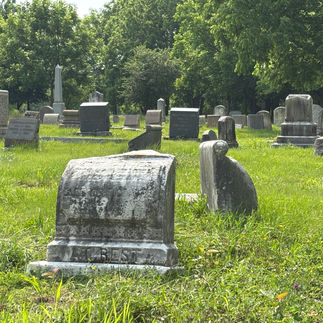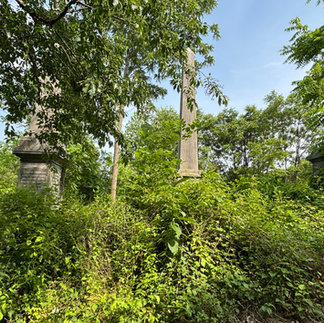forgotten in philadelphia
- Shellie Taylor
- Jun 23
- 5 min read

A few weekends ago, my best friend and I got to participate in a road trip that was long overdue for us (It had been more than ten years since we'd had such a trip). I flew from Charlotte to BWI where he picked me up and we drove to Long Island, NY for the wedding of a college friend of mine from Penn State. We had plenty of time and were in no rush in our travels, which was a good thing, because I don't know when it was the last time you drove up north, but traffic is ridiculous. I prefer my farm tractor traffic!
On the way up north, we stopped in Philadelphia because there was a cemetery I wanted to see. I had read about Mt. Moriah Cemetery in the book Cemetery Citizens: Reclaiming the Past and Working for Justice in American Burial Grounds by Adam Rosenblatt. First of all, I highly recommend this book. It talks about the injustice of systematically abandoned cemeteries. Working with Black cemeteries in Iredell County, this is a subject that I have become well acquainted with as well as very passionate about. However, there was an instant difference between the cemeteries with which I'm familiar and Mt. Moriah.
I am accustomed to African American cemeteries that have been abandoned and neglected with time because of who is buried within the grounds. Mt. Moriah surprised me because even though there are some marginalized community members buried here, the majority were wealthy and middle-class white Americans who lived during a time of rapid urban expansion in Philadelphia. So why was this over 300-acre cemetery in the middle of a huge metropolis left to neglect and disrepair?
The answer: Location.
Mt. Moriah was established in 1855 (same year as Penn State, I just want to point out!) as a response to a growing trend of garden-scape, wooded cemeteries. This trend was a response to the growing city populations and expansion of city limits. Where Mt. Moriah sits was only recently annexed and incorporated into the Philadelphia city limits when it was started. Several city churches would move their cemeteries to Mt. Moriah in the years following it's opening, the most notable being First Baptist Church which moved to a new building in 1860 and had their burials reinterred at Mt. Moriah. Thankfully, this was a well-documented process and the original records have been digitized and are available online. Some of these include early burials of Revolutionary War veterans, so even though the cemetery was established in 1855, many of the burials predate that year.
Another notable cemetery that was moved here was that of the Naval Plot which was associated with the U.S. Naval Asylum. Although the name implies a healthcare facility, it also operated as a school for midshipman prior to the opening of the U.S. Naval Academy in Annapolis, MD (my home town, by the way). The Annapolis academy opened in 1845 and the asylum in Philadelphia no longer served as a school. In 1865, the federal government purchased a large plot in Mt. Moriah and moved burials from the asylum to the newly established naval plot. This part of the cemetery is well-maintained as it is cared for by the Department of Veterans Affairs and it was very well-manicured at the time of my visit.

Betsy Ross, the woman who was said to have made the first American flag, was also once buried at Mt. Moriah. In 1976, as part of the bicentennial celebrations, she was relocated to a different burial spot closer to the Betsy Ross House on Arch Street.
So again, I emphasize that for the first several years of this cemetery's existence, Mt. Moriah was home to burials of mostly white middle-class Philadelphia residents. Early in the cemetery's history the area surrounding the grounds were inhabited by mostly immigrant Irish Americans. For anyone who has done research into Irish American history, they will know that Irish immigrants were not treated any better than Black citizens at the turn of the 20th century. Signs in businesses that read "Irish need not apply" were common in large cities that saw an influx of Irish immigration. As time went on and communities migrated within the city, the landscape surrounding Mt. Moriah changed from Irish immigrants to African Americans, which are who predominantly occupy this region today. This area has always been home to low-income, marginalized communities.
While we were visiting the cemetery, we tried to access the other half of the cemetery which is located across the street. Undeniably the largest part of the cemetery is situated between Kingsessing Avenue and Cobbs Creek Parkway which divides the two portions of the grounds. Unfortunately, the property along Kingsessing is inaccessible. After the cemetery's last owner died in 2004, there was a single caretaker until their death. The city forcibly closed Mt. Moriah to all future burials in 2011. No one bothered to inform descendants or loved ones about the closure; they were just suddenly cut off from the cemetery.
Another group of people buried here who have been looked down upon over time are that of Black Muslims. There is a portion of the cemetery north of Cobbs Creek Parkway that has several burials that are obviously Muslim from the crescent moon and star that appears on headstones, but there are multiple plots throughout the cemetery, many burials being recent, 21st century interments.
The Friends of the Mt. Moriah Cemetery group has formed and reformed over the years and hosted several cleaning days where volunteers have mowed grass, repaired headstones, and cut back weeds. The sad fact is that this place is massive and as much as I admire the efforts of the Friends group, it will take more members and local volunteers to maintain this cemetery on a regular schedule. Many of the sections we drove past were overgrown. Huge obelisks and very ornate marble and granite headstones are hidden behind excessive overgrowth. Stones are broken and laying over on their side. For a cemetery that was once a crowning jewel in the city of Brotherly Love, the sight of disrepair and abandonment is enough to break my heart.
To learn more about Mt. Moriah Cemetery and the people buried there, I highly encourage you to click on the links I've provided. If you or someone you know lives in Philadelphia and are interested in volunteering, reach out to the Friends of the Mt. Moriah Cemetery and get some events moving!
As always, thank you for reading and thank you for caring.






















































Comments